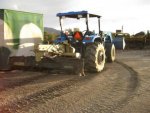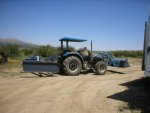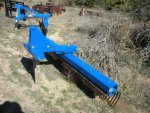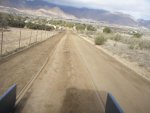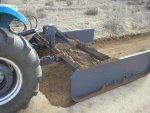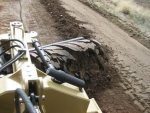Okay, I think I need to clarify by what I mean about moving material.
A front loader can load up a certain amount of material and move it from point A to point B and drop it right where you want it. That is 'moving' material to me.
A box blade can scrape up a certain amount of material and drag it a certain distance and either spread it or dump it at a destination. If you overfill the box, it just runs out the top and the back, a function you sometimes want and sometimes don't.
A regular blade can scrap up a certain amount of material (a roughly triangular cone/roll amount based on blade height and the gravity based angle holding factor of the material being scraped) and in perpendicular mode, move it to a new location, usually losing a certain amount off the ends of the blade and maybe over the top, a function you sometimes want and sometimes don't. An angled blade does the same but you always lose an amount off the rear edge of the blade, a function you want because you chose to angle the blade. It's not really 'moving' material in this mode, it's spreading, contouring or concentrating it.
A planer operates about the same as a box blade, it can have scarifers or rippers as well but doesn't generally require them. It normally has a shorter blade height and the function of losing material over the top/back of the blade sections is actually a major function of making it work, so that is desired. It moves a factor of material less than a box blade due to the lack of height and multiple blade edges help make up for this difference but it is not really used for material moving, more scraping and spreading of the scrapings. It can spread out materials very well, not so good at retaining them for longer distances.
So there is a difference in 'moving' ie: relocating over distance, materials and 'spreading' materials. All 3 items can spread materials, never said they couldn't. However if a storm washed half your long gravel driveway down into a drainage ditch, the box blade will put it back more quickly than the rear blade or planer will, not sure if the planer actually could.
If you have a relatively flat driveway that doesn't weather much, or gets maintained monthly, then, as I've said, any of the devices will work with the planer being the best, probably the blade next (or first) if you are in snow country, and the box blade last unless you do a lot of landscaping then it becomes first.
If you are always repairing big cuts or materials losses in your roadways, have side drainage ditches or hard packed roads, and you can only afford 1 implement, then the box blade is probably your best bet.
Each device has it strengths and weaknesses. It all depends on what you are going to do the most.
As far as the pictures, nice wet sand you are moving there. Don't think they'd look the same with hard packed gravel!

Then again, that's the point, the material you work with also has a big impact on what device to choose. Sand and DG is pretty forgiving. A gravel/DG mix is like concrete. Gravel and Asphalt tailings is actually a pretty good mix if you can keep it contained... which is a big if.


